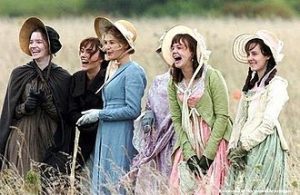29
Gender and Class in Pride and Prejudice (2005)
By Autumn Jernigan
With the French Revolution, Napoleon’s rise to power, and the dethroning and beheading of Marie Antoinette, the period in which Jane Austen wrote Pride and Prejudice (1813), was ripe with the history that impacted the themes of the novel. During this time, in the early 18th century, women were treated much differently than today and had lived by unequal expectations. The 2005 film adaptation of Pride and Prejudice, uses several different visual and audio techniques to shed light on how women and families of lower socioeconomic status of the early 19th century lived and were treated.
One aspect of Pride and Prejudice (2005) that must be considered is that all the characters are white and are completely able-bodied. The main focus of difference in this film is that of sex and socio-economic wealth. There is an obvious advantage to the characters of power and wealth, these characters all tend to be male. Mr. Darcy is seen in his larger-than-life estate. The use of props and scenery in Mr. Darcy’s marble statue room is a grand show of his worth. His reputation is also immense as he seems to be the non-stop talk of the town; everyone admires him, wants to be him, or wants to be with him. There is clear discrimination throughout the film for those lower on the socio-economic ladder. There is an expectation of how people should behave, different morals to live, and breathe by.

Those expectations are set by those of higher wealth and heritage and are expected to be followed by others. When characters of lower-economic wealth acted out against these “social norms,” they and their families would become a laughing stock. One example of this is when Lydia, a younger Bennet sister, had run off with Mr. Wickham. It is looked down upon for younger sisters to leave the house before the elder sisters are married. Mrs. Bennet is seen sobbing her eyes out in bed, great use of set design. Her dialog in this scene shows her disappointment in her daughter for potentially destroying her family’s reputation. It is therefore encoded with the repercussions of those who do not live within the rules and expectations of the higher class members of society. There are even more expectations for women to live by, for women in this time did not have as many rights as they do now.
Elizabeth Bennett is the main protagonist in Pride and Prejudice (2005); her family consists of her mother (Mrs. Bennet) and father (Mr. Bennet) and five sisters (Jane, Lydia, Kitty, and Mary). Women were not able to receive any inheritance from a family if a father were to die or abandon them, because of this, the Bennet family inheritance was promised to their cousin, Mr. Collins. This difference between male and “ female characters is social powerlessness under difficult and unequal conditions. We could see it through the patriarchy that always and explicitly serves men” (Mufa, 2016). This gender discrimination is an underlying theme throughout the movie. It is coded in the dialog and relationships (interactions) between the lower and higher economic class people.

This unfair system keeps women powerless and unable to receive an inheritance to be able to care for themselves. In this kind of system, parents push their daughters to marry into rich families, and oftentimes there are arranged marriages. In one scene, Mr. Darcy saves the Bennet family name. He does so by paying Mr. Wickham, a cheating gold digger, to marry Lydia Bennet, after she had run away with him. It was looked down upon for a family to allow their youngest daughter out of the house before the eldest was married. Women were especially looked down upon for having sexual relations with men, outside of marriage.
With men having a financial advantage, it is easy to see why they are portrayed as having more wealth and power than women. As it turns out, Jane Austen was in poor financial standing as she wrote the book in fact, she “her mother, and her sister Cassandra, was dependent for their living on three sources: a small income of Mrs. Austin’s, a small legacy of Cassandra’s, and the 250 pounds provided annually by the four Austen Brothers,” (Newton, Judith, 1978). In Pride and Prejudice (2005), the Bingley and Darcy estates are constantly being drooled over, and are subjects of admiration. There are several scenes in the film where Mrs. Bennet and others gossip incessantly over the worth of the estates, as well as the annual incomes of Mr. Bingley and Mr. Darcy. Mr. Darcy and Mr. Bingley seem to have control over the people of the lower class. They can bend the wills and minds to achieve their best interests. For instance, Jane Bennet was falling hard for Mr. Bingley, and vice versa. Mr. Darcy wanted to save his friend’s reputation and knew that if he married into a dysfunctional and lower-class family like the Bennet’s, other people would mock and think less of him. With power comes the responsibility of upholding the image of one in power, hence “pride.”
Elizabeth has a friend named Charlotte. There is a dialog between Mr. Bingley and Mrs. Bennet, in which Mrs. Bennet is talking badly of Charlotte, and having sympathy for her because of her lack of “handsomeness.” Later on in the film, Charlotte winds up marrying the boring, unattractive Mr. Collins (Bennet’s cousin). Elizabeth was horrified that her friend would settle for such a man, but Charlotte insisted that this was her only chance at a stable and happy life. It seems that one “center of activity in Pride and Prejudice is the operation of the marriage market, where a woman’s beauty is a precious commodity, bait for marriage trap, and her body is capital to be exploited. The male’s sexual susceptibility offers the females a point of attack” (Smith, Leroy, 1983). The Bennet’s knew that Jane, the eldest daughter would be married quickly, and were holding out for the wealthiest suitor. In the movie, Mr. Collins was first attracted to Jane, as was Mr. Darcy in the novel. This further proves that a woman’s attractiveness could hinder or destroy her in the early 19th century.
Visual techniques are used throughout the film to perpetuate discrimination against women, especially ones seen as “less handsome.” One scene particularly stands out to me. It was at the ball that Bennet’s, Mr. Darcy, and Mr. Bingley had attended and was where they all first met each other. After Elizabeth meets Mr. Darcy, she is seen in a dark room, gossiping with her friend Charlotte. Mr. Darcy comes into the shot, and starts speaking of Elizabeth’s unattractiveness, he even says that she was not pretty enough to interest a man such as himself. He did not know that Elizabeth was listening in on the conversation. This scene is a great insight into what men with pride, wealth, and power, say about women behind their backs. He was extremely rude, and discriminatory against the person who later turns out to be the love of his life.
With the use of dialect, we were able to hear Mr. Darcy’s true opinion of Elizabeth. We know that it was his opinion at this time because he didn’t think anyone was listening in on his conversation. By the use of prop and character placement, the scene was able to accurately convey how men talk about women “lesser” than them. The scene also took place at a ball in a very wealthy family’s house. High expectations were being held, and the Bennet’s don’t live by those standards. Perhaps Mr. Darcy was only saying those nasty things about Elizabeth because it was expected of him.
As a woman, I feel as though it is important to shed some light on the hardships women have overcome and are still overcoming. Pride and Prejudice (2005) is the perfect representation of the hardships of women in the early 19th century. The patriarchal system keeps women in less power and unable to be genuinely free to make our own decisions. By keeping women as the household caregivers, they never have the opportunity to create a name for themselves. I feel that this is why society today is changing so rapidly.
Women are no longer looked at as breeding machines, we are more than capable and wanting more than that, of dreams and aspirations. Women are more than just sex objects here to please and entertain that of the opposite sex. Elizabeth Bennet is an intelligent, well-spoken, independent young woman, and getting to see her perspective and attitude on life and marriage is refreshing to the world around her. She was an outlier, but because of that viewers get to see a different side to the system and to how women are represented.
Pride and Prejudice (2005) is chock-full of gossip, awkward tensions, displays of power, discrimination against the unwealthy and unattractive, and women’s struggle to be individual. Mr. Darcy puts aside his pride, and Elizabeth puts aside her prejudice in this love story where two people from opposite worlds come together and find love. It is a beautiful display of how women were treated as objects to be traded for promised generational wealth and safety. Women weren’t pushed to be themselves and to make their own decisions, unlike today. I recommend this film because it shows us how far we’ve come in women’s rights, but it also reminds us never to give up fighting for our individuality.
References
Mufa “Gender Construction in Pride and Prejudice.” Medium,Medium, 10 Dec. 2016, medium.com/@_mufarrohah/gender-construction-in-pride-and-prejudice-187eb7a83d0c.
Newton, Judith Lowder. “‘Pride and Prejudice’: Power, Fantasy, and Subversion in Jane Austen.” Feminist Studies, vol. 4, no. 1, 1978, p. 27., doi:10.2307/3177624.
Smith, LeRoy W. “Pride and Prejudice: No Improper Pride.” SpringerLink, Palgrave Macmillan, London, 1 Jan. 1983, link.springer.com/chapter/10.1007/978-1-349-17184-2_5.

